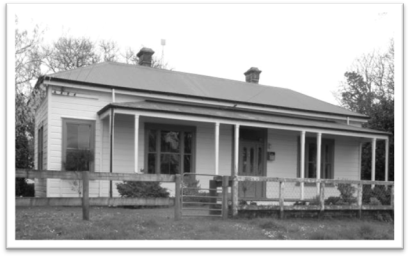HH-39: Woodstock Homestead and Farm Complex

Date of Photograph: 11/11/2008
Location and Zoning Information | |
Address |
Somerville Road (part of Somerville Farm 208 Somerville Rd) |
Current Owner |
Avec Lait Ltd |
Legal Description |
Lot 2 DP 3478 |
Zoning |
General Rural Zone |
Valuation Number |
0541108300 |
Google Maps Link |
|
Architecture | |
Date of Construction |
1883 |
Materials |
The house belonged to the Somerville family. In 1888-89 the house was moved in sections to the present site. |
Architecture/Engineer/Builder |
Built by the Thames Valley Land Company |
Condition |
Woodstock house has been added to over the years. The additions are at the rear of the house and there has been attention to matching the cladding |
Original Site Recommendation |
|
Current Use |
|
Statement of Significance |
Criteria for Scheduling: 1, 3, 6, 7, 10, 11, and 12 1. Historical aspect - associated with settlement of the district in the 1880’s, i.e. initially the timber industry and for most of its history agriculture. 3. Community association –Historic Woodstock Farm. 6. Educational Use –could be included as an item on a heritage trail. 7. Archaeology- pre 1900 the site is protected under the Heritage New Zealand Pouhere Taonga Act 2014; has the potential through archaeological investigation to provide information about New Zealand and the South Waikato District’s history. 10. Architectural- Example of Victorian Domestic Architecture. 11. Context cultural landscape/ complex or group – homestead set in a woodland garden with adjacent barn and fields. 12. Integrity –good condition. District Plan RulesDemolition –DIS. Protection focus - 1, 3, 5, 6, 10, 11, and 12. Mitigate the effects of demolition by requiring the applicant to provide a Historical Building Documentation (HBD) which should include: the structure’s history, photographic documentation, and measurements of the item prior to removal. Alterations necessary for the primary purpose of improving structural performance, fire safety or physical access – CON -Refer to HH-R2. Other Additions/Alterations - DIS. Refer to Rule HH-R3. Protection focus - 1, 3, and 10. Effects can be mitigated/ remedied through: a) HBD (see mitigating the effects of demolition). b) Design Rules: The overall visual character/ shape of the original building should be identifiable. The addition should not dominate the existing building frontage or affect the shape of the building. New work should be restricted to the rear of the building and in keeping with the building. Special elements that are associated with the rarity or architectural uniqueness or craftsmanship of the structure should be retained:
c) Building Materials Rule: If repair of the building is proposed the materials used for the exterior walls and elements should be similar in type, dimensions and profile as the historic fabric of the building. Repair of the Structure – PER. Refer to HH-R1. Protection focus – 1 and 10. a) Building Materials Rule: If repair of the building is proposed the materials used for the exterior walls and elements should be similar in type, dimensions and profile as the historic exterior fabric of the building. b) Design Rule: Repair or replication work should match the existing design, profile, and materials of the historic building elements. Reuse/ Change of Use – PER. Refer to HH-R1. Protection focus 1 and 3. This is generally allowed and supported. Rationale for supporting reuse- History is an ongoing process. Reuse of historic structures in most instances ensures the structure is retained for future generations. Advice or community concerns will be considered as well as economic viability, Occupational Safety and Health, zoning, etc. Disturbance of the site surface/earthworks – PER. Refer to HH-R1. Protection focus – 7. Existing plan rule relating to archaeological sites. This is a pre-1900 structure and there is a potential that archaeological deposits could be found if earthworks are carried out under or adjacent to the building. Internal Changes – PER. Refer to HH-R1. Protection focus – 10. Design Rule: Significant historic interior spaces, central hall, and use areas should be identifiable. Elements like fire place surrounds, architraves, double pocket doors, panelled ceilings, skirting, hardware, etc. Should be retained. Remodelling is allowed but alterations must be documented (HBD). Relocation – DIS. Refer to Rule HH-R3. Protection focus – 1 and 3. Relocation may be necessary to preserve an item for future generations. Mitigate the effects by 1) Consulting with the local community and/ or consulting with Iwi or special interest groups, 2) Relocating to a similar setting, 3) Documenting (HBD), 4) Applying rules relating to archaeological sites. |
History |
The house, garden, and barn should be included on the schedule as a farm complex. Woodstock homestead is located on a rise and is picturesque. The house is located on a farm and set in a woodland garden with large established trees, shrubs, perennials, and bulbs. There is an old garage and a barn adjacent to the house. Woodstock House has substantial architectural and landscape integrity. The architecture externally and internally is typical of quality homesteads of the 1880s and is one of a few homesteads in the South Waikato. It has a wide veranda and typical hipped gabled roof with double cross gables. The original elements of the building, central four panel glazed door with side lights and transom window, double hung sash windows with ornate architrave surround, have been retained along with the original chimneys, and many internal design features. Internal elements include pocket sliding doors, fire surrounds, paneled ceilings, ornate architraves and skirting, etc. Land use consent was granted on 2 February 2012 for alterations and a minor extension to Woodstock homestead. The applicants proposed to remove the existing modern rear extension and construct a new larger extension in its place. Internal remodelling and alterations to the existing layout, including the provision of a new bathroom and additional en-suite facilities etc were also proposed, with verandahs added to the side and rear. The proposed alterations were to enable the property to be used as guest house accommodation. |
Additional Photographs
